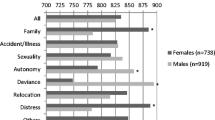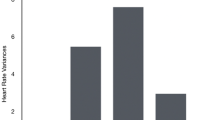Abstract
Among adults, both normal and pathological worrying has been found to be associated with a unique emotional syndrome involving irritability, restlessness, low frustration tolerance and difficulty relaxing. This emotional state is empirically distinguishable from anxiety and depression, and is reliably assessed by the Stress scale of the Depression Anxiety Stress Scales (DASS). The association between worry and ‘stress’ may have important implications for a better theoretical understanding of worrying in adults. Among youth, however, the emotional experience associated with worrying has not yet been clearly described. The present study aimed to explore whether a distinct, adult-like ‘stress’ syndrome can be assessed in adolescents via self-report, and whether, as in adults, stress has a specific association with worrying. A simplified version of the DASS was created to maximize its comprehension by adolescents. A group of 340 12–18-year-olds completed the simplified DASS and a self-report measure of worry. Factor analyses revealed a three-factor structure underlying the simplified DASS, similar to the original adult version. Further analyses showed that worry had a unique association with Stress, over and above its association with Depression and Anxiety. Adolescents who worry more excessively and uncontrollably also reported higher levels of irritability, restlessness and difficulty relaxing, while the autonomic arousal symptoms of anxiety had consistently low associations with worrying, especially in older adolescents. Results indicate that the proposed cognitive avoidance function of worrying may be present by adolescence.
Similar content being viewed by others
References
Aldao, A., & Mennin, D. (2012). Paradoxical cardiovascular effects of implementing adaptive emotion regulation strategies in generalized anxiety disorder. Behaviour Research & Therapy, 50, 122–130.
American Psychiatric Association. (1987). Diagnostic and statistical manual of mental disorders (3rd ed.). Washington: American Psychiatric Association.
American Psychiatric Association. (2000). Diagnostic and statistical manual of mental disorders IV-Text Revised (DSM-IV-TR). Washington: American Psychiatric Association.
Andrews, G., Hobbs, M. J., Borkovec, T. D., et al. (2010). Generalized worry disorder: a review of DSM-IV generalized anxiety disorder and options for DSM-V. Depression and Anxiety, 27, 134–147.
Antony, M. M., Bieling, P. J., Cox, B. J., Enns, M. W., & Swinson, R. P. (1998). Psychometric properties of the 42-item and 21-item versions of the Depression Anxiety Stress Scales in clinical groups and a community sample. Psychological Assessment, 10, 176–181.
Bayram, N., & Bilgel, N. (2010). Turkish version of the Depression Anxiety Stress Scale (DASS-42): Psychometric properties. Archives of Neuropsychiatry, 47, 118–126.
Bell-Dolan, D. J., Last, C. G., & Strauss, C. C. (1990). Symptoms of anxiety disorders in normal children. Journal of the American Academy of Child & Adolescent Psychiatry, 29, 759–765.
Borkovec, T. D., & Hu, S. (1990). The effect of worry on cardiovascular response to phobic imagery. Behaviour Research and Therapy, 28, 69–73.
Borkovec, T. D., & Inz, J. (1990). The nature of worry in generalized anxiety disorder: a predominance of thought activity. Behaviour Research and Therapy, 28, 153–158.
Borkovec, T. D., Alcaine, O. M., & Behar, E. (2004). Avoidance theory of worry and generalized anxiety disorder. In R. G. Heimberg, C. L. Turk, & D. S. Mennin (Eds.), Generalized anxiety disorder: advances in research and practice (pp. 77–108). New York: Guilford Press.
Brown, T. A., Marten, P. A., & Barlow, D. A. (1995). Discriminant validity of the symptoms constituting the DSM-III-R and DSM-IV associated symptom criterion of generalized anxiety disorder. Journal of Anxiety Disorders, 9, 317–328.
Brown, T. A., Chorpita, B. F., Korotitsch, W., & Barlow, D. H. (1997). Psychometric properties of the Depression Anxiety Stress Scale (DASS) in clinical samples. Behavior Research and Therapy, 35, 79–89.
Cartwright-Hatton, S. (2006). Worry in childhood and adolescence. In G. Davey & A. Wells (Eds.), Worry and its psychological disorders: theory, assessment and treatment (pp. 81–97). Chichester: Wiley.
Chorpita, B. F., Tracey, S. A., Brown, T. A., Collica, T. J., & Barlow, D. H. (1997). Assessment of worry in children and adolescents: an adaptation of the Penn State Worry Questionnaire. Behaviour Research and Therapy, 35, 569–581.
Crawford, J. R., & Henry, J. D. (2003). The depression anxiety stress scales (DASS): normative data and latent structure in a large non-clinical sample. British Journal of Clinical Psychology, 42, 111–131.
Davey, G. C. L. (1994). Pathological worrying as exacerbated problem-solving. In G. C. L. Davey & F. Tallis (Eds.), Worrying: perspectives on theory, assessment and treatment (pp. 35–61). Chichester: Wileys.
Duffy, C. J., Cunningham, E. G., & Moore, S. M. (2005). Brief report: the factor structure of mood states in an early adolescent sample. Journal of Adolescence, 28, 677–680.
Fabrigar, L. R., Wegener, D. T., MacCallum, R. C., & Strahan, E. J. (1999). Evaluating the use of exploratory factor analysis in psychological research. Psychological Methods, 4, 272–299.
Freeston, M. H., Dugas, M. J., & Ladouceur, R. (1996). Thoughts, images, worry, and anxiety. Cognitive Therapy and Research, 20, 265–273.
Freeston, M. H., Dugas, M. J., Letarte, H., & Rheaume, J. (1996). Physical symptoms associated with worry in a non-clinical population. Journal of Anxiety Disorders, 10, 365–377.
Gong, X., Xie, X., Xu, R., & Luo, Y. (2010). Psychometric properties of the Chinese version of the DASS-21 in Chinese college students. Chinese Journal of Clinical Psychology, 18, 443–446.
Gosselin, P., Langlois, F., Freeston, M. H., et al. (2007). Cognitive variables related to worry among adolescents: avoidance strategies and faulty beliefs about worry. Behaviour Research and Therapy, 45, 225–233.
Hale, W. W., III, Raaijmakers, Q., Muris, P., Van Hoof, A., & Meeus, W. (2008). Developmental trajectories of adolescent anxiety disorder symptoms: a 5-year prospective community study. Journal of the American Academy of Child and Adolescent Psychiatry, 47, 556–564.
Henry, J. D., & Crawford, J. R. (2005). The short-form version of the depression anxiety stress scales (DASS-21): construct validity and normative data in a large non-clinical sample. British Journal of Clinical Psychology, 44, 227–239.
Holaway, R. M., Rodebaugh, T. L., & Heimberg, R. G. (2006). The epidemiology of worry and generalized anxiety disorder. In G. L. C. Davey & A. Wells (Eds.), Worry and its psychological disorders: theory, assessment and treatment (pp. 3–21). Chichester: Wiley. Ch 1.
Huang, K., Szabó, M., & Han, J. (2009). The relationship of low distress tolerance to excessive worrying and cognitive avoidance. Behaviour Change, 26, 223–234.
Keith, T. Z. (2006). Multiple regression and beyond. Boston: Pearson.
Kim-Cohen, J., Caspi, A., Moffitt, T. E., et al. (2003). Prior juvenile diagnoses in adults with mental disorder: developmental follow-back of a prospective-longitudinal cohort. Archives of General Psychiatry, 60, 709–717.
Laugesen, N., Dugas, M. J., & Bukowski, W. M. (2003). Understanding adolescent worry: the applicability of a cognitive model. Journal of Abnormal Child Psychology, 31, 55–64.
Lovibond, P. F. (1998). Long-term stability of depression, anxiety, and stress syndromes. Journal of Abnormal Psychology, 107, 520–526.
Lovibond, P. F., & Lovibond, S. H. (1995a). The structure of negative emotional states: comparison of the depression anxiety stress scales (DASS) with the beck depression and anxiety inventories. Behavior Research and Therapy, 33, 335–343.
Lovibond, S. H., & Lovibond, P. F. (1995b). Manual for the depression anxiety stress scales. Sydney: Psychology Foundation Monograph.
Marten, P. A., Brown, T. A., Barlow, D. H., et al. (1993). Evaluation of the ratings comprising the associated symptom criterion of DSM-III-R generalized anxiety disorder. Journal of Nervous and Mental Disease, 81, 676–682.
Mathews, A. (1990). Why worry? The cognitive function of anxiety. Behaviour Research and Therapy, 28, 455–468.
Mennin, D. S., Heimberg, R. G., Turk, C. L., & Fresco, D. M. (2005). Preliminary evidence for an emotion dysregulation model of generalized anxiety disorder. Behaviour Research and Therapy, 43, 1281–1310.
Meyer, T. J., Miller, M. L., Metzger, R. L., & Borkovec, T. D. (1990). Development and validation of the Penn State Worry Questionnaire. Behaviour Research and Therapy, 28, 487–495.
Muris, P., Meesters, C., Merckelbach, H., Sermon, A., & Zwakhalen, S. (1998). Worry in normal children. Journal of the American Academy of Child & Adolescent Psychiatry, 37, 703–710.
Norton, P. J. (2007). Depression anxiety and stress scales (DASS-21): psychometric analysis across four racial groups. Anxiety, Stress & Coping, 20, 253–265.
Patrick, J., Dyck, M., & Bramston, P. (2010). Depression anxiety stress scale: is it valid for children and adolescents? Journal of Clinical Psychology, 66, 1–12.
Salters-Pedneault, K., Roemer, L., Tull, M. T., Rucker, L., & Mennin, D. S. (2006). Evidence of broad deficits in emotion regulation associated with chronic worry and generalized anxiety disorder. Cognitive Therapy and Research, 30, 469–480.
Starcevic, V., Fallon, S., & Uhlenhuth, E. H. (1994). The frequency and severity of generalized anxiety disorder symptoms. Toward a less cumbersome conceptualisation. Journal of Nervous and Mental Disease, 182, 80–84.
Szabó, M. (2007). Do children differentiate worry from fear? Behaviour Change, 24, 195–204.
Szabó, M. (2009). Worry in adults and children: developmental differences in the importance of probability and cost judgments. Journal of Psychopathology and Behavioral Assessment, 31, 235–245.
Szabó, M. (2010). The short version of the depression anxiety stress scales (DASS-21): factor structure in a young adolescent sample. Journal of Adolescence, 33, 1–8.
Szabó, M. (2011). The emotional experience associated with worrying: anxiety, depression or stress? Anxiety. Stress and Coping, 24(1), 1–15.
Szabó, M., & Lovibond, P. F. (2006). Anxiety, depression, and tension/stress in children. Journal of Psychopathology and Behavioural Assessment, 28, 195–204.
Tully, P. J., Zajac, I. T., & Venning, A. J. (2009). The structure of anxiety and depression in a normative sample of younger and older Australian adolescents. Journal of Abnormal Child Psychology, 37, 717–726.
Vasey, M. W. (1993). Development and cognition in childhood anxiety: The example of worry. In T. H. Ollendick & R. J. Prinz (Eds.), Advances in clinical child psychology (pp, Vol. 15, pp. 1–39). New York: Plenum.
Vasey, M. W., Crnic, K. A., & Carter, W. G. (1994). Worry in childhood: a developmental perspective. Cognitive Therapy and Research, 18, 529–549.
Wells, A. (1999). A cognitive model of generalized anxiety disorder. Behaviour Modification, 23, 526–555.
Acknowledgments
The authors would like to thank all participants and school personnel for their invaluable support, without which this project would not have been possible.
Author information
Authors and Affiliations
Corresponding author
Additional information
This research was partly supported by a grant from the National Health and Medical Research Council awarded to the second author.
Rights and permissions
About this article
Cite this article
Fowler, S., Szabó, M. The Emotional Experience Associated with Worrying in Adolescents. J Psychopathol Behav Assess 35, 65–75 (2013). https://doi.org/10.1007/s10862-012-9316-3
Published:
Issue Date:
DOI: https://doi.org/10.1007/s10862-012-9316-3




